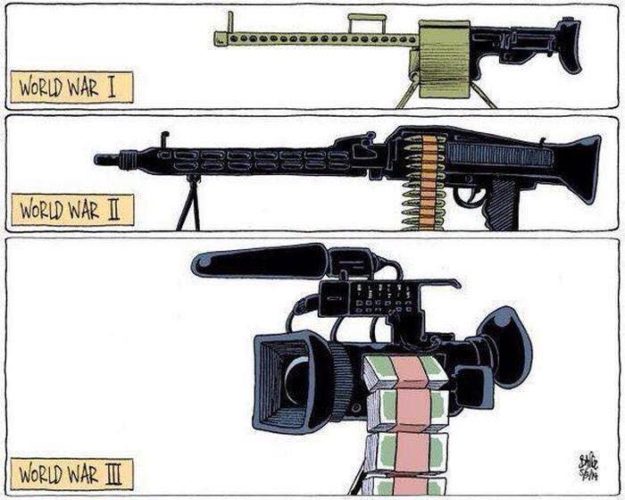9/11 AND THE EMIRATES – THE SHOCKING REVELATION
Thliban/Al Oaeda – 9/11 Attack
THE September 11 attacks were a series of four coordinated terrorist attacks by the Islamic
terrorist group AL-Qaeda on the United States on the morning of Tuesday, September 11, 2OOl.
The attacks killed 2,996 people, injured over 6,000 others, and caused at least $10 billion in
infrastructure and property damage.
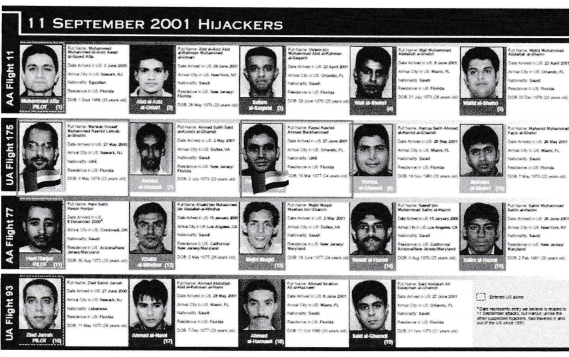
Fifteen of the 19 were citizens of Saudi Arabia, and the others were from the United Arab
Emirates (2) Egypt and Lebanon.
The hijackers deposited money into U.S. accounts, primarily by wire transfers and deposits of
cash or travelers checks brought from overseas.
Additionally, several of them kept funds in foreign accounts, which they accessed in the United
States through ATM and credit card transactions. The hijackers received funds from facilitators
in Germany and the United Arab Emirates or directly from Khalid Sheikh Mohamed (KSM) as
they transited Pakistan before coming to the United States.
The plot cost al Qaeda somewhere in the range of $400,00G-500,000, of which
Approximately $300,000 passed through the hijackers’ bank accounts in the United
States.
Marwan al Shehhi was being paid by the UAE military, which was sponsoring his studies in
Germany. He continued to receive a salary through December 23,2000.
The funds were deposited into his bank account in the
United Arab Emirates and then wired by his brother, who held power of attorney over the
account, to his account at Dresdner Bank in Germany (although there is no evidence that alShehhi’s
brother knew about or supported the plot). Binalshibh was employed interrnittently
in Germany until November 1999.
Ziadlarah apparently relied on his family for support. The United Arab Emirates, the financial
center for the Gulf area, also had a reputation for being “wide open,” with few regulations on the
control of money and a woefully inadequate anti-money-laundering prograrn.32 The UAE
system had been a concern of U.S. policymakers long before the 9/lL attacks, and they directly
raised their concerns with UAE officials. The UAE had no money-laundering law, although at
U.S. urging in 1999 it started drafting one, which was not finalized until after 9/11. Although the
UAE was aware that terrorist and other international criminals had laundered money through the
UAE, and that it was the center for hawala and courier operations, it did little to address the
problem. Additionally, the United States expressed its concern about UAE support for Ariana
Airlines and the movement of Bin Laden funds through UAE
Shorty before the September 11 attacks, the departing U.S. ambassador to the UAE warned
senior officials in the Emirates that they needed to move forward on money-laundering
legislation, so as not to be placed on the Financial Action Task Force (FATF) “blacklist” of
countries not fully complying with international standards in this area. These warnings had no
discemible effect. Indeed, Binalshibh said that Jarrah always seemed to have plenty of money in
Germany because his parents gave it to him.
Upon their arrival in the United States, the hijackers received a total of approximately $130,000
from overseas facilitators via wire or bank-to-bank transfers. Most of the transfers originated
from the Persian Gulf financial center of Dubai, UAE, and were sent by plot facilitator Ali. Ali is
the nephew of KSM, the plot’s leader, and his sister is married to convicted terrorist Ramzi
Yousef. He lived in the UAE for several years before the September 11 attacks, working for a
computer wholesaler in a free trade zone in Dubai.
According to Ali, KSM gave him the assignment and provided him with some of the necessary
funds at a meeting in Pakistan in early 2000. KSM provided the bulk of the money later in 2000
via a courier. Although Ali had two bank accounts in the UAE, he kept most of the funds for
the hijackers in a laundry bag at home. Ali transferred a total of $119,500 to the hijackers in
the United States in six transactions between April 16, 2000, and September 17,2000. Nawaf al
Hazmi and Khalid al Mihdhar, the first hijackers to arrive, received the first wire transfer. On
April 16, 2000, Ali, using the name “Mr. Ali,” wired $5,000 from the Wall Street Exchange Centre in Dubai to an account at the Union Bank of California.
The funds flowed through a coffespondent account at the Royal Bank of Canada. Ali brought the
$5,000 to the Exchange Center in cash. The Wall Street Exchange Center required identification,
and it made a copy of Ali’s work ID, along with his cell phone number and work address-all of
which helped the FBI identify him and his subsequent aliases after 9/11.
Ali wired the money to the account of a San Diego resident whom Hazmi met at a mosque and
had solicited to receive the transaction on his behalf. Ali wire transferred a total of $114,500
to the plot leaders shehhi and Atta after their arrival in the united states.
Ali did not return to the Wall Street Exchange Centre. Instead, using a variety of aliases, he sent
the money from the UAE Exchange Centre in Dubai, where no identification was required. On
June 29,2000, Ali, using an alias, sent a $5,000 wire transfer to a Western Union facility in New
York where Shehhi picked it up.
Over the next several months, Ali sent four bank-to-bank transfers directly to a checking
account jointly held by Shehhi and Atta at SunTrust Bank in Florida: $10,000 on July 18, $9,500
on August 5, $20,000 on August 29, and$70,000 on September 17.
On three of these occasions he used an alias; once he went by “Mr. Ali.” In each case, Ali
brought cash in UAE Dirham’s, which were then changed into dollars; the transaction receipts
reflect the conversion. All of the bank-to-bank transactions flowed through the UAE Exchange’s
correspondent account at Citibank. Although Ali made the last five transactions using various
aliases, he provided enough personal information to enable the FBI to unravel the aliases after 9/11.
The United States raised concerns with the United Arab Emirates seven years
ago about possible ties between officials in that counffy and Osama bin Laden, according to a
section of the Sept. 11 commission’s report that details a possible missed opportunity to kill the
al-Qaida leader.
The report states U.S. intelligence believed that bin Laden was visiting an area in the Afghan
desert in February 1999 near a hunting camp used by U.A.E. officials, and that the U.S. – Military
planned a missile strike.
Intelligence from local tribal sources indicated “bin Laden regularly went from his adjacent
camp to the larger camp where he visited the Emirates,” the report said.
“National technical intelligence confirmed the location and description of the larger camp and
showed the nearby presence of an official aircraft of the United Arab Emirates. But the location
of bin Laden’s quarters could not bepinned down so precisely,” the reportsaid.
The missile attack was never launched, and bin Laden moved on, the report said.
A month later, top White House counter terrorism official Richard Clarke “called a U.A.E. official to express his
officials and bin Laden.”
The UAE is mentioned over 70 times in the 9/11 Commission Report and related documents,
including one on terrorist financing. The report found most of the attackers travelled through
Dubai on their way to the US, and money used to finance the attacks “flowed through the
UAE,” and that the hijackers received money from facilitators in the UAE.
The 9/11 report recalls the UAE “becoming both a valued counter terrorism ally” and “a
persistent counterterrorism problem” in 1999, and references a missed chance to kill Osama Bin
Laden in February as visitors from the UAE were using the same camp, and there were fears a
strike “would kill an Emirati prince or other senior officials.”
The Telegraph reports that these leaked communications reveal how both the UAE and Saudi
Arabia have been working jointly to lobby against the US Congress’ passing the Justice against
Sponsors of Terrorism Act (JASTA) last year, with Ambassador Al Otaiba coordinating with
Saudi Foreign Minister Adel al-Jubeir on the issue.
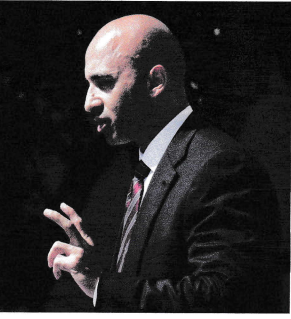
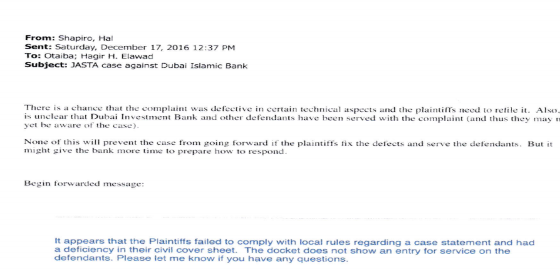
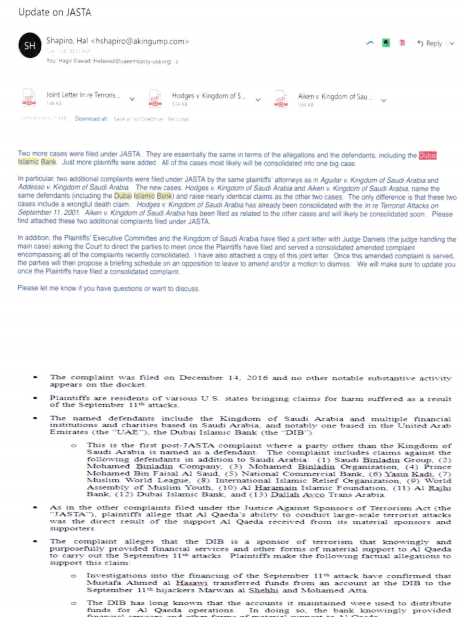
It is now a known fact that two of the 19 hijackers who flew planes into the World Trade Center
towers in New York in 2001 were UAE born citizens, while 15 were saudis.
The United Arab Emirates suggested it might withdraw intelligence cooperation with the US in an attempt to block
legislation allowing families of September 11 victims to sue Saudi Arabia and UAE for compensation.
Leaked emails seen by the Telegraph show how Yousef Al Otaiba, the UAE’s ambassador to Washington DC, privately warned senators that countries at risk of being sued in US
courts would be “less likely to share crucial information and
intelligence”.
The communications reveal how UAE joined Saudi Arabia, work to lobby against the Justice against Sponsors of
Terrorism Act (Jasta), with Mr Al Otaiba coordinating his efforts with Adel al-Jubeir, the Saudi foreign minister.
The case naming Dubai Islamic Bank as a defendant was flagged up with Mr Al Otaiba on
December 15, as “the flrst Jasta complaint involving a UAE party as a defendant”.
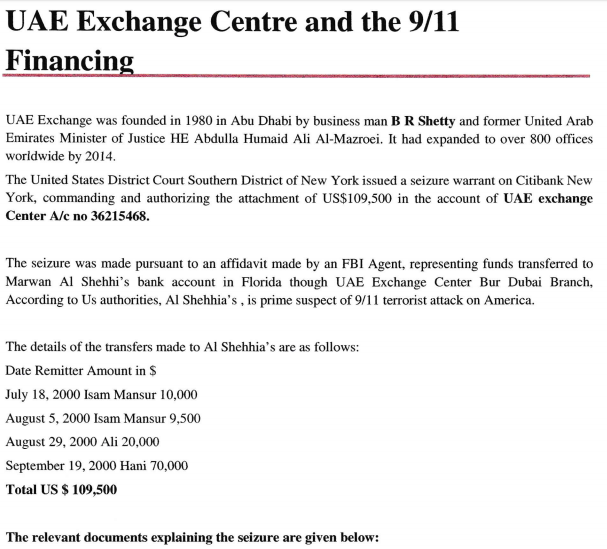
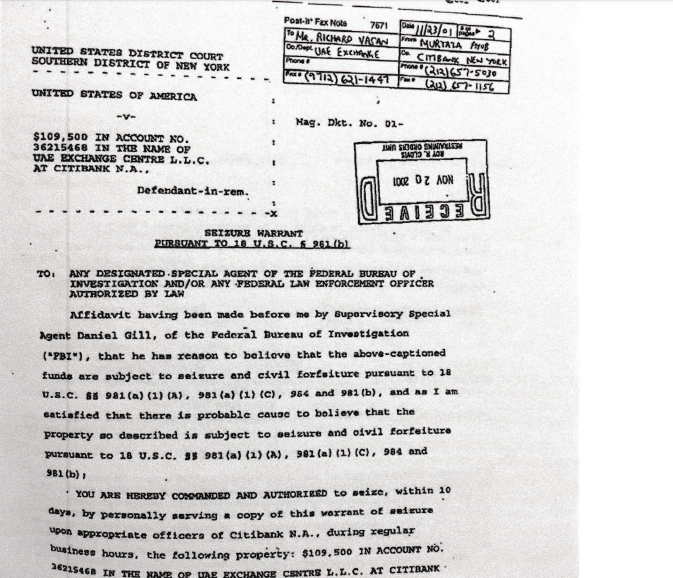
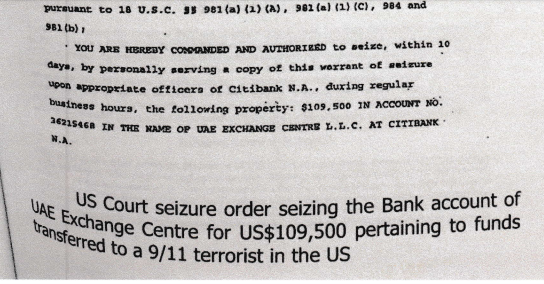
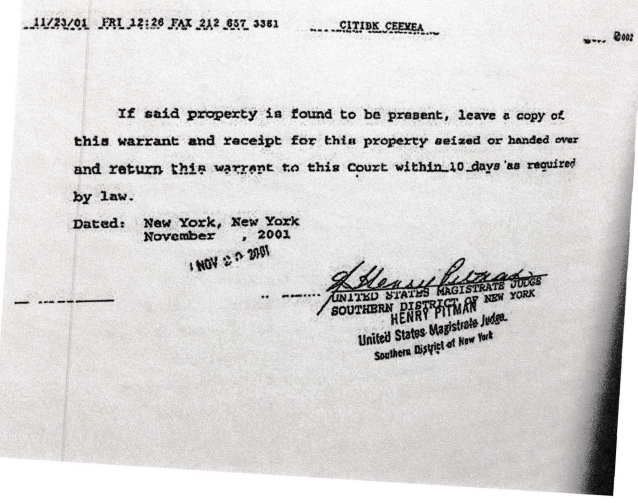
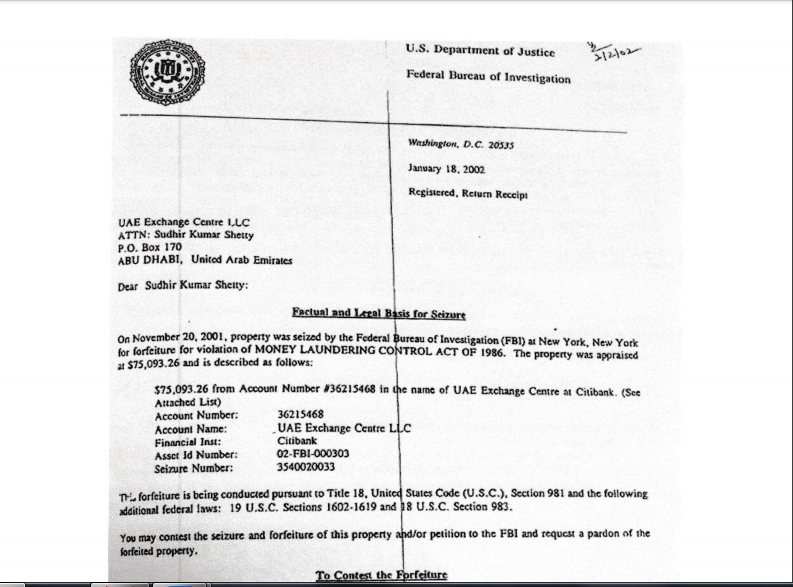
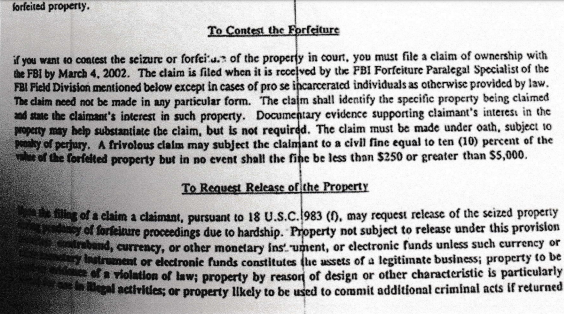
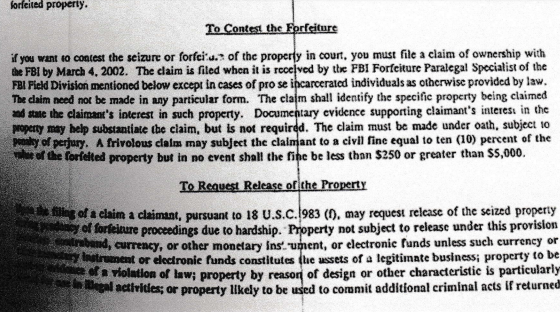
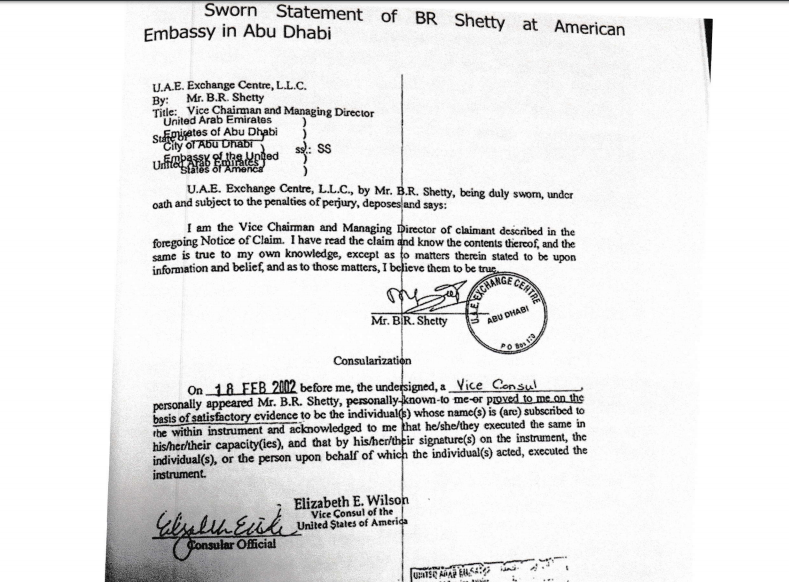
Source:
International anti terrorism investigation group –
Madrid 9/11 2018

